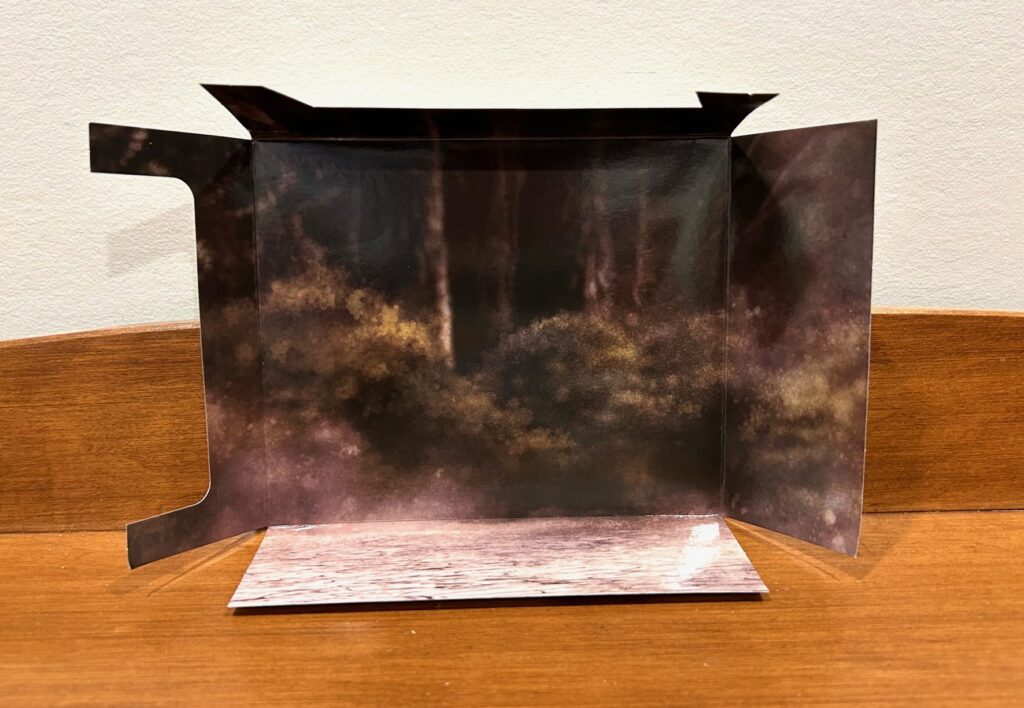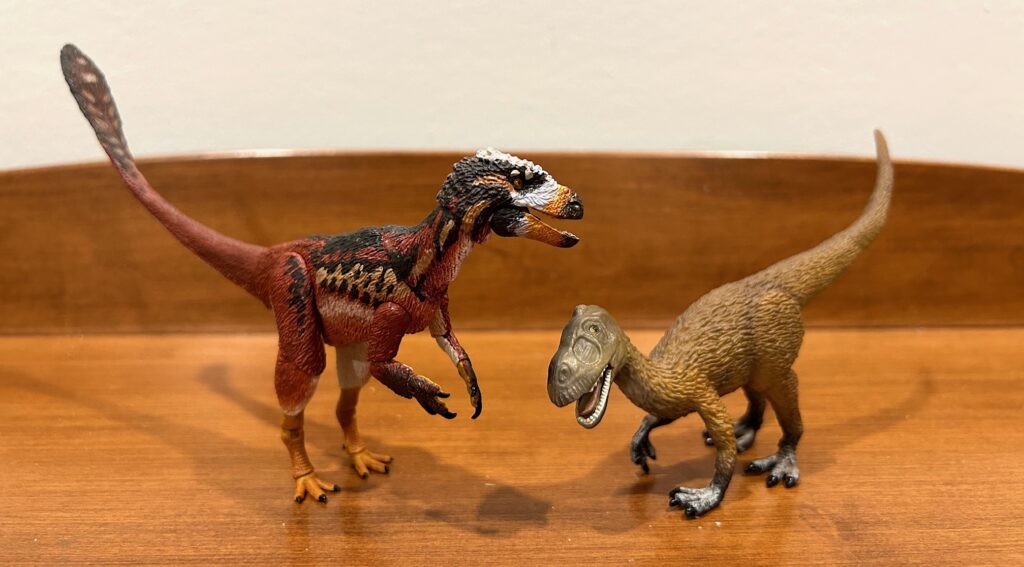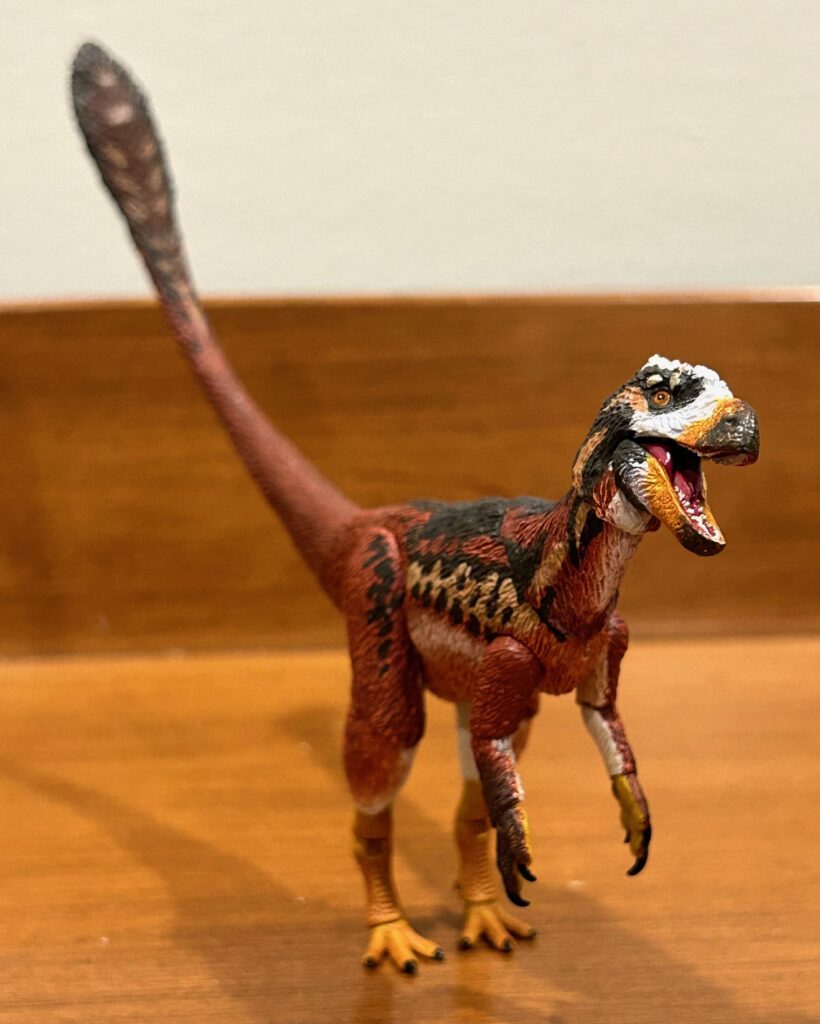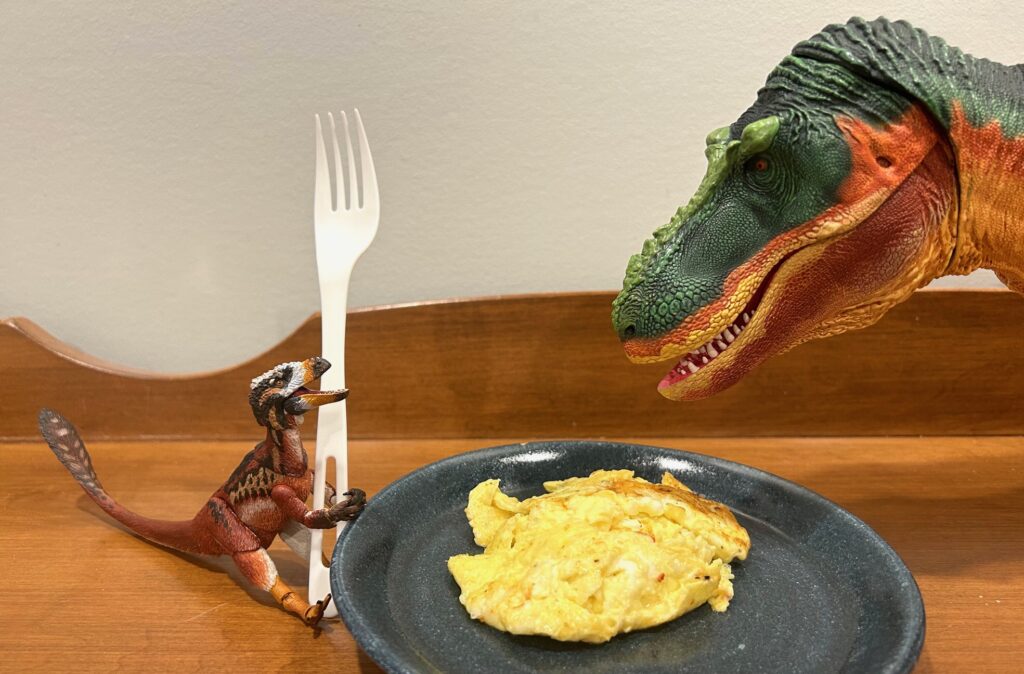
As the Neovenator pair appears on the scene, the nesting Iguanodons begin rising to their feet and bellowing aggressively. The carnivores pace back and forth rapidly in front of them, jaws snapping and sharp eyes scanning for any discernible weaknesses as they attempt to panic the big herbivores into stampeding. But what neither predators nor potential prey notice is a smaller figure decked in red, white, and black emerge silently from the scrub brush on the opposite side of the nesting ground, scurry with great fluckadrift directly underneath the raised tail of an Iguanodon, pluck an egg out of the nest with its jaws, and hightail back into the brush again. The poacher carefully lays the egg down on the ground, then darts out again to steal a second one without anyone noticing her still. Finally, she sits down to enjoy her meal and observe the larger dinosaurs continue to confront each other. As she bites into the first egg, Sionnach ponders whether or not the Neovenators will succeed in providing her with yet another opportunity for an easy meal . . .

‘Twas exactly one year ago today that I posted my first Beasts of the Mesozoic Tyrannosaur review to the Dinosaur Toy Blog. It remains by far the longest review I’ve written (5628 words!), and the very best one in my humble opinion. And now I’m wrapping up my tyrannosaur trio with this review of Eotyrannus, part of the third and final wave.

As always, we begin with the box. While I knew that it would be much smaller than those of the Tyrannosaurus rex and the Teratophoneus, I was nevertheless surprised at its size. It measures just 17 cm long x 14 cm tall x 6 cm wide. The superb artwork by Shannon Beaumont on the front depicts the Eotyrannus standing triumphantly atop a dead Hypsilophodon in a dark forest setting.

The back of the box includes the Eotyrannus‘ bio, stats, and features, a catalog shot of the figure, and headshots of the rest of Wave 3. There is one factual error in the bio: Eotyrannus was indeed a tyrannosauroid, but definitely not a tyrannosaurid. Still, anyone who’s bought or planning to buy this figure is most likely well aware of its proper place in the tyrannosaur dynasty, so not that big of a deal.

The insert shows the same dark forest as on the box art. Presumably this is centered around a lake or a river, as back in the Early Cretaceous some 127 million years ago, the Wessex Formation is thought to have been a semi-arid land similar to modern California or the Mediterranean. In addition to Eotyrannus, Neovenator, Iguanodon, and Hypsilophodon, the known residents include ankylosaurs Polacanthus and Vectipelta, ornithopods Brighstoneus, Mantellisaurus, and Valdosaurus, spinosaurs Ceratosuchops and Riparovenator, the dromaeosaur Vectiraptor, and pterosaurs such as Caulkicephalus.

Here’s the collectible BotM card, featuring the exact same information and imagery as on the box. I have to say, I’ve really come to adore Shannon Beaumont’s paleoart. Hopefully she’ll continue to do more for the upcoming Cyberzoic and Beasts of the Cenozoic series in addition to future BotM series.

And that brings us to the Eotyrannus, whom I’ve dubbed Sionnach, pronounced “she-OH-knock-AW” in Scottish Gaelic. She’s currently my smallest BotM figure at 21 cm in length and 8.5 cm in height when standing in a neutral horizontal pose like the one above. Her colouration is based on an extant European predatory dinosaur: the red kite. Brick red is the main colour, with white applied to the insides of her arms and legs and on her flanks. The underside of her tail is pale orange and the tip is dark brown and black with light brown spots. Light brown and black markings adorn her neck, torso, and thighs. Her feet are dull orange, her hands are dark brown on the outside and mustard yellow on the inside, and her claws are glossy black.


Sionnach’s head is painted white, black, and light brown with a dark yellow muzzle tipped with dark brown. Her eyes are medium brown with glossy black pupils and her mouth is glossy dark red with white teeth. It all looks superb and quite believable. Sadly, the pupils on my figure have been painted as though they’re looking in different directions like a chameleon. Makes Sionnach look a bit derpy when viewed from the front. Also, her upper teeth have been painted as a single curving line, whereas her bottom teeth are better defined.

And let’s enjoy some comparison shots. First we have Sionnach confronting the Eotyrannus that CollectA released all the way back in 2010. Quite the stark contrast, no? I donated the latter to a kindergarten classroom’s dinosaur bin the day right after this image was taken. Certainly had no need for it anymore.

Here’s Sionnach with some fellow diminutive tyrannosauroids: the Carnegie Collection Dilong, the CollectA Xiongguanlong, the PNSO Proceratosaurus, and the Wild Safari Guanlong.

And finally, here she is with Marbhtach and Sealgair. I’m very pleased that I chose to pledge for these three; they definitely show how diverse the tyrannosaur family was in terms of size and appearance. Hopefully we’ll eventually get a megaraptoran or two in the future.


Small though she may may, Sionnach’s sculpting is every bit as magnificent as her larger kin. Her snout is covered in tiny round scales and her teeth are reasonably pointy. Her feet have the usual rows of scutes and round scales that we’re accustomed to seeing on theropod figures. The palms of her hands have creases to denote the joints, but are otherwise smooth. The backs of her hands, meanwhile, are covered in feathers, as is the rest of her body.

These are not the pennaceous, bird-like feathers we see on dromaeosaurs and oviraptorosaurs; they are instead the more primitive plumaceous or downy feathers that certain tyrannosauroids are known to have had. Most of Sionnach’s plumage looks short and fuzzy, but her forearms and head have a thicker, shaggier appearance. The tip of her long tail ends in a large fan, purely speculative at the moment, but plausible. The claws on her feet are puny, but the ones on her hands are fairly large, curved, and lethal-looking.

Now, as far as accuracy is concerned, Sionnach is pretty good on the whole. For certain she strongly resembles most scientific illustrations of Eotyrannus, which is currently only known from very fragmentary remains. However, a 2022 monograph by paleontologists Darren Naish and Andrea Cau resulted in a new reconstruction that has a significantly smaller head, bigger hands, and bigger feet. But it must be noted that the monograph came out well after this sculpting for this figure had been completed. Revising it would have seriously delayed production and cost a great deal of money. Such is the curse of prehistoric figures: regularly being shown to be inaccurate in some way by new discoveries and publications. Personally, I think the issues are relatively minor. The figure also has a slight underbite, most noticeable when the mouth is closed.

Sionnach’s mouth opens to the usual degrees, but unlike larger BotM theropods, her tongue is not articulated. Her head and neck rotate a full 360 degrees in either direction. Her shoulders are ball-jointed, her elbows are hinged, and her wrists have universal joints, although they look bad when rotated (and, of course, they couldn’t be rotated in real life anyway). Her hips and toes are ball-jointed and her knees and ankles have universal joints. Finally, her bendable tail attaches via a ball joint. As always, it is imperative that you take a hairdryer to your own Eotyrannus in order to loosen up all these joints and avoid any breakage. Despite the small size of Sionnach’s feet, she can be put into a decent range of poses as you’ve seen.

Sionnach’s base measures 9 cm long and slightly over 6.5 cm wide, and is sculpted to look like dull brown rocks with a large patch of green moss, some medium brown roots, and a large hole for attaching the support rod. Unlike with the bases for the larger tyrannosaurs in the series, there are no pegs for attaching the feet, which are too small to have holes in the soles.

Here are the four alternative feet, with one pair having the toes bent and spread apart and the other having the toes held close together. They’re relatively easy to swap out, although again, best to warm up the joints and sockets first. A single clear support rod and two curved clips with ball joints are also included. Attaching the rod to the base was a challenge that required a good bit of heating as well, but once installed, it was all fine.

Getting Sionnach into some dynamic action poses without her falling over requires a good bit of patience and precision, but that’s par for the course and part of the fun, isn’t it? And for safety’s sake, I’ll be keeping her in a more neutral and stable pose in the display case just like with my other two tyrannosaurs.


Overall, I’m rather pleased with the BotM Eotyrannus. The red kite colour scheme is excellent, one of the best ones in the whole series. Sculpting is as impressive as always, poseability is good, and it’s quite impressive how the figure is able to stand well on its own in spite of its small feet. Granted, there are a few inaccuracies, but again, through no fault of David Silva’s. He used what information was available and up to date at the time. And finally, small tyrannosauroids still haven’t got very many figures to their name compared to their much larger tyrannosaurid descendants, so this one, as well as the others in the series, is most welcome indeed!

And thus does Sionnach complete my trio of BotM tyrannosaurs. Don’t reckon I’ll be acquiring anymore, sadly, for the usual accursed reasons of limited space and funds. But Cyberzoic and Beasts of the Cenozoic loom large on the horizon in addition to future BotM series, so I can definite promise that this is not the last such review from me. 🙂

“Humph!”
Trending Products











